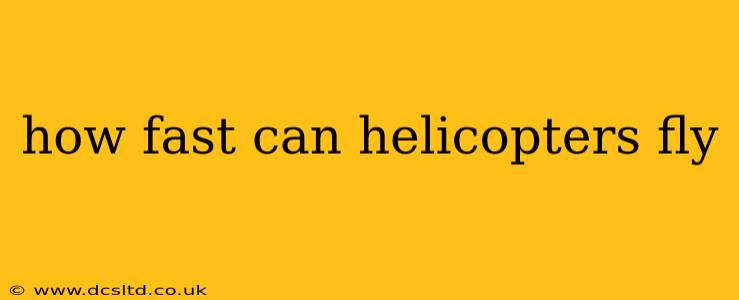Helicopters, marvels of engineering, offer unparalleled vertical flight capabilities. But how fast can these versatile aircraft actually go? The answer, as with many things, is "it depends." A helicopter's maximum speed isn't a single number; it varies significantly based on several factors. This guide delves into the specifics, exploring the influencing factors and answering common questions about helicopter speed.
What Determines a Helicopter's Speed?
Several key factors influence a helicopter's top speed:
-
Helicopter Model: Different helicopter models are designed for different purposes. A small, lightweight helicopter designed for civilian use will have a significantly lower top speed than a large, military attack helicopter built for speed and maneuverability. Larger rotors, more powerful engines, and aerodynamic designs all contribute to higher speeds.
-
Payload: The weight a helicopter carries directly impacts its speed. A heavier load necessitates more power to maintain lift, reducing the helicopter's overall speed. Think of it like driving a car uphill versus on a flat road – carrying extra cargo (payload) is like driving uphill.
-
Altitude: As altitude increases, air density decreases. This thinner air provides less lift and requires the helicopter to work harder, resulting in lower speeds at higher altitudes.
-
Weather Conditions: Wind speed and direction significantly affect a helicopter's ground speed. Strong headwinds will reduce the helicopter's forward progress, while tailwinds will increase it. Turbulence can also impact speed and handling.
-
Engine Power: The power of the engine is directly correlated to the helicopter's potential speed. More powerful engines can generate the necessary lift and thrust for faster speeds.
What is the Average Speed of a Helicopter?
There's no single "average" speed for all helicopters. However, a reasonable estimate for many civilian helicopters used for tasks like passenger transport or sightseeing is between 80 and 150 mph (130-240 km/h). Military helicopters can reach significantly higher speeds, often exceeding 200 mph (320 km/h).
What is the Fastest Helicopter Ever Made?
The current record holder for the fastest helicopter is the Westland Lynx, which achieved a speed of 249 mph (401 km/h) in 1986. This remarkable speed is, however, a record specifically for straight and level flight, and exceptional conditions are required to reach it. Most helicopters do not reach these speeds in normal operation.
How Fast Can a Military Helicopter Fly?
Military helicopters, designed for speed and maneuverability, often reach much higher speeds than civilian models. Specific speeds vary greatly depending on the model and its mission. Some attack helicopters can exceed 200 mph (320 km/h), while others prioritize maneuverability over pure speed.
How Fast Can a Small Helicopter Fly?
Small civilian helicopters typically have much lower top speeds, often ranging from 80 to 120 mph (130-190 km/h). Their design prioritizes maneuverability and ease of operation over raw speed.
Why Don't Helicopters Fly Faster?
Several engineering challenges limit a helicopter's top speed. The rotor system, which is fundamental to a helicopter's lift and control, becomes increasingly inefficient at higher speeds. At higher speeds, the rotor blades approach the speed of sound, creating considerable drag and reducing the effectiveness of lift. Additionally, the higher speeds generate significant vibrations and stress on the aircraft's structure. Overcoming these limitations is a complex engineering problem and would likely require significant design changes and technological advancements.
This detailed analysis provides a comprehensive understanding of the many factors influencing helicopter speed, dispelling any assumptions about a single "top speed" for all helicopters. The diverse range of helicopter models, their specific design purposes, and external conditions all play significant roles in determining how quickly a helicopter can fly.
